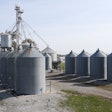Commercial pellet producers strive for a high durability and a very low percentage of fines. Even so, problems can occur that may lead to complaints, calls to pick up the feed or worse.
To understand how feed flows inside a bin, a small silo with a Plexiglas side was constructed to illustrate how some problems may develop.

The central column empties and pulls feed from the top of the bin. | LignoTech USA
Bin flow experiment
In the first example, the silo was loaded with layer crumbles. It was loaded from directly above; at 25 percent intervals, small amounts of rabbit pellets were added as markers (Figure 1, left). Researchers added rabbit pellets because their dark color provided a good contrast to the high-corn crumbles.
In the crumbled feed, the segregation of fines from larger particles was obvious. Solid light-colored layers fill the central column while larger dark-colored particles have rolled down the slope to the outside of the bin.
The gate was then opened and the bin was emptied by a feeder screw. Feed flowed downward from directly above the gate opening; there was little or no flow from the sides. When about 25 percent of the volume had been removed, the pile was transformed into an inverted cone (Figure 1, middle). Pellets and crumbles flowed down this slope to fill the vortex that was continuously being removed directly above the outlet gate.
Withdrawal continued until only 30 percent of the initial material remained (Figure 1, right). The lowest layer of rabbit pellets on the sides have not moved at all. In this case, the bin was emptied first from its central core and then from the top. Material on the bottom sides did not move.

Crumbles at the bottom of the bin are the last to exit. | LignoTech USA
The trouble with co-mingling in the bin
What if a new feed was added into this bin before it was empty? Would the layer crumbles come out first? To investigate this, the bin was refilled with rabbit pellets mixed with 20 percent fines (Figure 2, left). The fines show up more clearly in this case. They have stayed in the center of the bin where the incoming stream hit the pile and the pellets have rolled down the slope to the sides of the bin.
The first feed to come out of the bin was a small amount of layer crumbs. The central column followed and it contained a high concentration of fines. If fat or enzymes had been applied post-pelleting this would create significant nutrient segregation.
As the pile became an inverted cone, pellets began to roll down the slope and into the vortex. The contrast between these clean pellets and the fines-laden column was obvious (Figure 2, middle). Eventually, the pellets were almost completely removed and the layer crumbs from the earlier loading began to flow into the vortex (Figure 2, right).
The bottom layer of rabbit pellets from the first loading still had not moved, which could create several problems.
First, if that feed stays long enough it is likely to mold and then remain in place until it is physically cleaned out. If the bin is emptied completely at this time, the load of rabbit pellet will be contaminated with layer crumbs at the end. If the original feed was medicated and the later feed was a non-medicated, withdrawal ration, the resulting adulteration could require a quarantine.

This graph shows that the last feed to exit the bin had very few pellets because it was residual layer crumbs. | LignoTech USA
Eventually, the bin was emptied completely and the percentage of pellets was measured (Figure 3). Initially, there was less than 20 percent pellets; this was the layer crumb still left in the bin. This was followed by 60 percent pellets as the central column containing most of the fines emptied out.
After a transition, the percentage of pellets increased to greater than 90 percent. These were the relatively clean pellets flowing down-slope from the outside of the bin into the vortex. The percentage of pellets plummets at the end as the last of the layer crumbles come out, much to everyone’s surprise.
Findings revealed
This study helps to understand how feed flows in a bin. There are a few rules that explain all of the things we observed:
- Fines fill voids between pellets and larger particles; fines stay where they land while larger particles roll down-slope.
- Voids will be filled from above; bins empty the central column first.
- Down-slope flow into the vortex causes bins to unload from the top; there is no lateral flow from areas not close to the central column.
The observations made in this small silo are believed to occur in a similar manner in larger systems. As the diameter of the silo increases, the central column will represent a smaller proportion of the total volume, but it may still contain all of the fines if the feed is loaded directly into the center.
Bottom line:
- Segregation will occur when material (feed) with particles of different size is loaded into a bin; a more uniform particle size with fewer fines will have less segregation.
- Bins should be emptied completely whenever possible to avoid feed spoilage and/or contamination.
For further examination of this study and its significance, attend the free webinar, "Segregation in bulk silos: What is really happening?" sponsored by Borregaard LignoTech and presented by WATT Global Media, on Wednesday, February 15, 2017 at 9 a.m. CST. Click here to register.
















